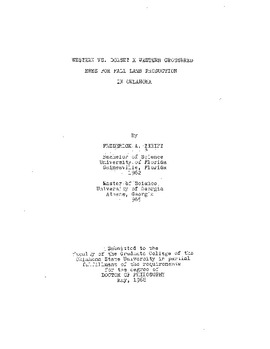| dc.contributor.advisor | Whiteman, J. V. | |
| dc.contributor.author | Thrift, Frederick A. | |
| dc.date.accessioned | 2016-02-16T20:23:56Z | |
| dc.date.available | 2016-02-16T20:23:56Z | |
| dc.date.issued | 1968-05 | |
| dc.identifier.uri | https://hdl.handle.net/11244/30422 | |
| dc.description.abstract | Scope of Study: A comparison was made between the lifetime performance of two ewe breed groups involved in~ fall lambing program in Oklahoma. The two breed groups compared were Western ewes [Panama, 3/4 Rambouillet x 1/4 Merino, Rambouillet 1 3/4 Rambouillet x 1/4 Columbia and "Whiteface Market" (part Columbia, Panama or Corriedale mixed with Rambouillet)] and Dorset x Western ewes [Dorset x Rambouillet and Dorset x (3/4 Rambouillet x 1/4 Panama)]. These two breed groups (120 ewes each) were compared on the basis of the growth performance of their lambs (birth weight, rate of gain from birth to 70 days, 70-day weight, rate of gain from 70 days to market, market age), their reproductive performance (percent ewes lambing, lambing rate, lambs reared per 100 ewes, lambing date) and their wool production (grease and clean fleece weights). The regular breeding season for these ewes began on May 20 and continued for 40 days. A "cleanup" breeding period was permitted from August 20 to September 20 for those ewes failing to conceive during the regular breeding season. This breeding procedure resulted in fall (Oct. 15-Nov. 25) and winter (Jan. 15-Feb. 15) lambing. | |
| dc.description.abstract | Findings and Conclusions: Findings and Conclusions: The results of this study indicate that each of the lamb growth variables were similar for both breed groups. During the fall, a higher percentage ( 7.7%, P<. 05) of the Dorset x Western ewes lambed, they had a higher lambing rate (0.19, P<.001), reared more lambs per 100 ewes in the flock (22.6, P<.05) and consistently lambed about three days earlier (P<.01) than the Western ewes. During the winter, 4.3 percent fewer Dorset x Western ewes lambed than the Western ewes but the lambing rate was similar for both breed groups. The high lambing rate. Of the Dorset x Western ewes was .due to a large number of multiple births. During the two seasons, the Dorset x Western ewes gave birth to 722 twins and 39 triplets; whereas, the Western ewes gave birth to 470 twins and 15 trip-lets. The Western ewes consistently produced grease fleeces that were about two pounds heavier (P<.01) than those of the Dorset x Western ewes, but the clean fleece weights were quite similar for both breed groups. | |
| dc.format | application/pdf | |
| dc.language | en_US | |
| dc.rights | Copyright is held by the author who has granted the Oklahoma State University Library the non-exclusive right to share this material in its institutional repository. Contact Digital Library Services at lib-dls@okstate.edu or 405-744-9161 for the permission policy on the use, reproduction or distribution of this material. | |
| dc.title | Western vs. Dorset x Western crossbred ewes for fall lamb production in Oklahoma | |
| osu.filename | Thesis-1968D-T531w.pdf | |
| osu.accesstype | Open Access | |
| dc.type.genre | Dissertation | |
| dc.type.material | Text | |
| thesis.degree.discipline | Animal Breeding | |
| thesis.degree.grantor | Oklahoma State University | |
